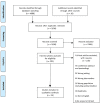The current and possible future role of 3D modelling within oesophagogastric surgery: a scoping review
- PMID: 35277766
- PMCID: PMC9283150
- DOI: 10.1007/s00464-022-09176-z
The current and possible future role of 3D modelling within oesophagogastric surgery: a scoping review
Abstract
Background: 3D reconstruction technology could revolutionise medicine. Within surgery, 3D reconstruction has a growing role in operative planning and procedures, surgical education and training as well as patient engagement. Whilst virtual and 3D printed models are already used in many surgical specialities, oesophagogastric surgery has been slow in their adoption. Therefore, the authors undertook a scoping review to clarify the current and future roles of 3D modelling in oesophagogastric surgery, highlighting gaps in the literature and implications for future research.
Methods: A scoping review protocol was developed using a comprehensive search strategy based on internationally accepted guidelines and tailored for key databases (MEDLINE, Embase, Elsevier Scopus and ISI Web of Science). This is available through the Open Science Framework (osf.io/ta789) and was published in a peer-reviewed journal. Included studies underwent screening and full text review before inclusion. A thematic analysis was performed using pre-determined overarching themes: (i) surgical training and education, (ii) patient education and engagement, and (iii) operative planning and surgical practice. Where applicable, subthemes were generated.
Results: A total of 56 papers were included. Most research was low-grade with 88% (n = 49) of publications at or below level III evidence. No randomised control trials or systematic reviews were found. Most literature (86%, n = 48) explored 3D reconstruction within operative planning. These were divided into subthemes of pre-operative (77%, n = 43) and intra-operative guidance (9%, n = 5). Few papers reported on surgical training and education (14%, n = 8), and were evenly subcategorised into virtual reality simulation (7%, n = 4) and anatomical teaching (7%, n = 4). No studies utilising 3D modelling for patient engagement and education were found.
Conclusion: The use of 3D reconstruction is in its infancy in oesophagogastric surgery. The quality of evidence is low and key themes, such as patient engagement and education, remain unexplored. Without high quality research evaluating the application and benefits of 3D modelling, oesophagogastric surgery may be left behind.
Keywords: 3D printing; Augmented reality; Computer-generated 3D imaging; Gastrointestinal diseases; General surgery; Virtual reality.
© 2022. The Author(s).
Conflict of interest statement
The authors contributing to this manuscript Mr Henry Robb, Ms Gemma Scrimgeour, Mr Piers Boshier, Ms Anna Przedlacka, Dr Svetlana Balyasnikova, Professor Gina Brown, Professor Fernando Bello, and Mr Christos Kontovounisios, have no conflicts of interest to declare or financial relationships relevant to the generation and publication of this research.
Figures
Similar articles
-
How is 3D modeling in metabolic surgery utilized and what is its clinical benefit: a systematic review and meta-analysis.Int J Surg. 2025 May 1;111(5):3159-3168. doi: 10.1097/JS9.0000000000002301. Int J Surg. 2025. PMID: 40009557 Free PMC article.
-
Current and possible future role of 3D modelling within oesophagogastric surgery: a scoping review protocol.BMJ Open. 2021 Oct 7;11(10):e045546. doi: 10.1136/bmjopen-2020-045546. BMJ Open. 2021. PMID: 34620652 Free PMC article.
-
The impact of extended reality on surgery: a scoping review.Int Orthop. 2023 Mar;47(3):611-621. doi: 10.1007/s00264-022-05663-z. Epub 2023 Jan 16. Int Orthop. 2023. PMID: 36645474 Free PMC article.
-
Current and future role of three-dimensional modelling technology in rectal cancer surgery: A systematic review.World J Gastrointest Surg. 2021 Dec 27;13(12):1754-1769. doi: 10.4240/wjgs.v13.i12.1754. World J Gastrointest Surg. 2021. PMID: 35070078 Free PMC article.
-
Beyond the black stump: rapid reviews of health research issues affecting regional, rural and remote Australia.Med J Aust. 2020 Dec;213 Suppl 11:S3-S32.e1. doi: 10.5694/mja2.50881. Med J Aust. 2020. PMID: 33314144
Cited by
-
Artificial intelligence driven 3D reconstruction for enhanced lung surgery planning.Nat Commun. 2025 May 1;16(1):4086. doi: 10.1038/s41467-025-59200-8. Nat Commun. 2025. PMID: 40312393 Free PMC article.
-
Anesthesia videos in geriatric and elderly patients on YouTube: content, quality, reliability, and usefulness assessment.PeerJ. 2025 Apr 17;13:e19280. doi: 10.7717/peerj.19280. eCollection 2025. PeerJ. 2025. PMID: 40256732 Free PMC article.
-
Evaluation of anesthesia-related videos in patients with obesity on the youtube platform in terms of quality, reliability, and usefulness.Medicine (Baltimore). 2025 May 16;104(20):e42445. doi: 10.1097/MD.0000000000042445. Medicine (Baltimore). 2025. PMID: 40388777 Free PMC article.
-
How is 3D modeling in metabolic surgery utilized and what is its clinical benefit: a systematic review and meta-analysis.Int J Surg. 2025 May 1;111(5):3159-3168. doi: 10.1097/JS9.0000000000002301. Int J Surg. 2025. PMID: 40009557 Free PMC article.
-
Could tumour volume and major and minor axis based on CTA statistical anatomy improve the pre-operative T-stage in oesophageal cancer?Cancer Med. 2023 Jul;12(13):14037-14051. doi: 10.1002/cam4.6051. Epub 2023 Jun 12. Cancer Med. 2023. PMID: 37306615 Free PMC article.
References
-
- Kim N, Lee S, Gwon E, Seo JB. The value in 3D printing. Med Radiol. 2020 doi: 10.1007/174_2019_207. - DOI
-
- Landini L, Positano V, Santarelli MF. 3D medical image processing. In: Neri E, Caramella D, Bartolozzi C, editors. Image Processing in radiology: current applications. Springer, Berlin Heidelberg: Berlin, Heidelberg; 2008. pp. 67–85.
Publication types
MeSH terms
LinkOut - more resources
Full Text Sources



